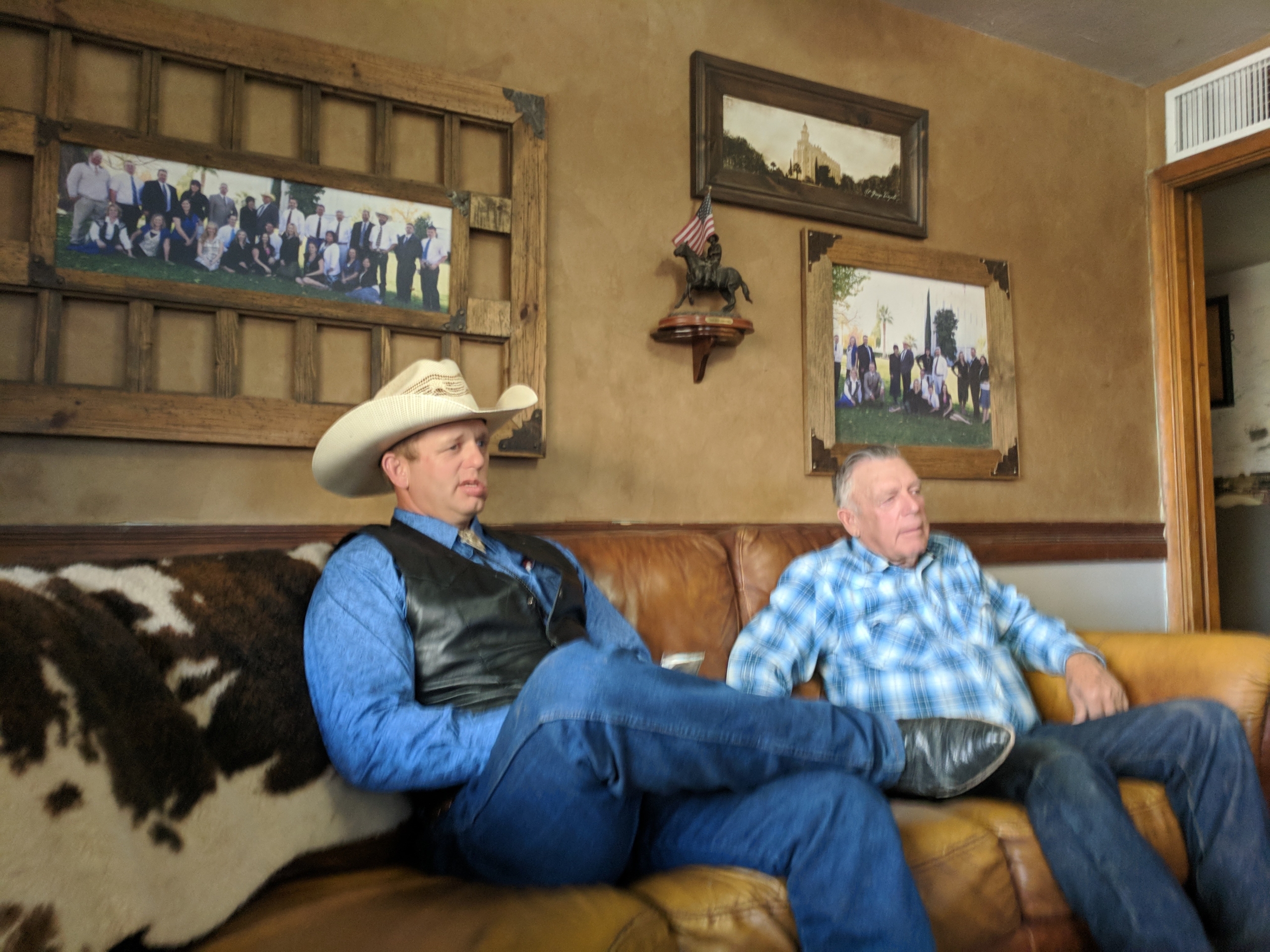Sign up for the daily CJR newsletter.
ON A FRIDAY IN LATE MARCH, reporter Leah Sottile and her producer Ryan Haas drove up the road to Bundy Ranch near Bunkerville, Nevada. Four years earlier, the now-infamous cattle rancher Cliven Bundy had led an armed standoff there against the federal government over grazing fees. The two weren’t sure if they would meet Bundy, let alone interview him. But as they pulled in, there he was, clad in white rubber boots and a barn coat, “looking like he had just been shoveling hay for his cattle,” Haas says. Bundy invited them inside his modest house, which was surrounded by trucks and tractors and even an old school bus.
Sottile and Haas plopped down on the soft leather couch in the living room. The scent of barbecue sauce lingered in the air. It was surreal, Haas says. They were sitting face-to-face with someone they had spent months researching. “You feel like you know them, but you also don’t know them,” Haas says. “When you’re covering the Bundys in the middle of these standoffs, it’s 10 seconds or a couple of minutes at the most.” The news media wants “soundbites, and that’s all they [the Bundys] are giving.”
ICYMI: 11 images that show how the Trump administration is failing at photography
That afternoon was different. Bundy and his son Ryan sat with the two reporters as they asked nearly two pages worth of questions. They talked about their experiences on the ranch, growing up in the West, their faith. For Sottile, the story of the Bundys is so much bigger and deeper than anyone, including her, realized. “It was going to take a really long time to unpack all of the history around the family and around the movement,” she says.
But unpack they did, in the form of a new podcast (and multipart series) from Longreads and Oregon Public Broadcasting. Released last month and spread across seven episodes, Bundyville is the story of Cliven Bundy, his family, their followers, and the ways in which their “range rights” movement is changing the American West. As Sottile says on the podcast, to understand the West, you have to understand the Bundys—an ongoing effort that has taken many national news outlets years.
In a way, the situation in 2014 unfolded so quickly and the media did what they could to understand what was happening.
CLIVEN BUNDY HAS BEEN in the national spotlight since 2014, when he and an armed militia held off the feds from rounding up his cattle. For years, the 72-year-old had illegally used federal land surrounding his ranch and refused to pay grazing fees. Two years after the standoff, Bundy’s sons led an armed occupation of the Malheur National Wildlife Refuge in Oregon to protest the government’s imprisonment of two ranchers (even though the ranchers in question did not want the Bundys involved). The occupation lasted just over a month, and eventually led to the arrest of Cliven, his sons Ammon and Ryan, and more than two dozen followers. In January, all three Bundys (and their fellow supporters) walked free. A jury acquitted the brothers and other Malheur occupiers in Oregon, and a judge declared a mistrial in Nevada.
Bundy is many things to many people, including those in the news media. A cowboy, Mormon leader, folk hero, peaceful farmer, and prophet to some; a criminal, racist, cult leader, and terrorist—even dubbed “Vanilla ISIS” & “Y’All Qaeda”—to others. When Bundy rose to infamy, however, he was primarily covered by the mainstream media as he wanted to be seen. News organizations like The Guardian offered up sympathetic profiles of the family and its cause, positioning the Bundys as the “oppressed” and the federal government as “the oppressors.” Writing in The Guardian, Sam Levin described the Bundys as “rebel cowboys” and their followers as “activists,” albeit “rightwing” ones. Such frames tend to overlook the complex issues tied up with the Bundy story, from the history of range management to the protection of the desert tortoise.
Bundy’s so-called “range rights” movement actually dates back to the rancher-led Sagebrush Rebellion of the 1970s, as reported for years by High Country News. The magazine, which covers the American West, is one of the few news organizations that has been on the Bundy beat since the very beginning. “In a way, the situation in 2014 unfolded so quickly and the media did what they could to understand what was happening,” says Sottile. “But I don’t think we were able to get out in front of the narrative that the Bundys were trying to put there.”
RELATED: How journalism got so out of touch with the people it covers
The Bundys are brilliant marketers who positioned themselves as a nice, pure, wholesome family being screwed over by the government. They took their campaign to social media early on; now, Bundy Ranch has more than 200,000 followers on Facebook. They leveraged far-right media from InfoWars to Fox News to YouTube personalities. At press conferences, says Haas, Bundy would purposely give “misinformation meant to present a very specific image of what they wanted to see portrayed in the media.”
Bundyville complicates that portrait. Using news clips, Serial-esque narration, and occasionally heavy-handed scoring, Bundyville takes a diagnostic approach to the notorious family. Sottile began covering the Bundys closely in 2016 during the trial in Nevada; Cliven and his sons, Ammon and Ryan, faced charges stemming from their armed rebellion two years earlier. “I was desperate to understand why Cliven Bundy, this remote cattle rancher, had such firm ideas about the Constitution and where he learned these things,” she says.
Still, even in very deliberate coverage, Cliven Bundy presents a compelling and sympathetic image—all the facts some people need. “In the age of social media and in the age of the internet, there’s so much information coming in, and we kind of just get pieces of it,” says Haas. “You’re sitting there talking to him and he’s telling you stories like he’s your grandpa. It’s very easy to believe him.”
MEDIA NARRATIVES STARTED TO SHIFT two years ago, during the Malheur occupation in Burns, Oregon. That time, the Bundys couldn’t get away with playing the victim card. “You had Ryan Bundy and Ammon Bundy coming across state lines, taking over a wildlife refuge with a whole crowd of people armed to the teeth, saying ‘We’re taking over this refuge and will stay for years until we get what we want.’ It put them on the offensive,” Sottile says.
There was a swell in news coverage. “The media recognized that something really important happened in Nevada that maybe they should’ve been on the ground with,” Sottile says. Local and regional news organizations like The Oregonian (thanks to reporters such as Maxine Bernstein) and public radio station OPB churned out exhaustive reporting over the 41-day occupation, and journalists from national media organizations flew to Burns, Oregon. One of those journalists, James Pogue, recently turned his on-the-ground experiences at Malheur into a book, Chosen Country. Another journalist, Jennifer Percy, revisited the region for The New York Times Magazine in January to understand the residents’ ongoing fear of the federal government.
In this second round of Bundy coverage, reporters were able to get ahead of the story. “With the benefit of hindsight in Oregon, we had a much clearer picture of what this was all about,” says Kirk Siegler, an NPR reporter covering America’s rural-urban divide. Siegler started covering the Bundys in 2014, a month after the standoff. Soon it became clear to him “that this thing going on in the desert was more of a broader example of the rural resentment and perceptions of government overreach and rural rebellion that helped propel Donald Trump to the White House,” he says. The Bundys represent a fringe movement, something that got lost in the initial round of media coverage. When it comes to Western ranchers, the Bundys are outliers. Most ranchers in the West pay their grazing fees to the federal government, with no intention of stopping, says Tay Wiles, associate editor at High Country News.
The majority of Bundy supporters aren’t ranchers or farmers or cowboys, but militiamen, anti-government agitators, and white supremacists—the kind of people who flocked to Charlottesville last summer. That’s something Bundyville excavates in its fifth episode, “The Followers,” and other journalists have investigated in more recent reports in The New Yorker and Newsweek. “They had their own anger they were carrying and knew nothing of federal lands,” Siegler says. “We know a lot more about that now.” Bundy’s movement isn’t about range rights. It’s about being anti-federal government, with heavy elements of domestic terrorism and conspiracy theory, according to Sottile. A few episodes of Bundyville examine the historical roots of the Bundys’ anti-government ideology—for example, how growing up near a nuclear testing site helped radicalize Cliven.
The story of the Bundys is a hydra, says Petersen, the BuzzFeed reporter.
Post-trial, a lot of coverage of the Bundys has become equal parts reflective and forward-thinking. Now it’s about the context, not the characters. It places the family, their cause, and their rhetoric within the recent history of the American West. Writing for High Country News, Wiles analyzed how the federal government helped make Cliven Bundy a celebrity. Shortly after Cliven Bundy’s release from prison in January, BuzzFeed’s Anne Helen Petersen wrote about another right-wing insurgency gaining traction in the West. Bundy had gone to Paradise, a small town in Montana, where he preached his gospel to a crowd of people packed into the local schoolhouse. “The hundreds who showed up in Paradise weren’t just there to hear him speak,” wrote Petersen. “They were waiting to be told what to do next.” That’s up in the air, but Petersen knows what she’s doing next—a series of in-depth stories about the Bundys (currently in progress for BuzzFeed). One of Petersen’s colleagues, Salvador Hernandez, deconstructed the nascent—and conspiracy-laced—gubernatorial campaign of Cliven’s son Ryan, who is now running for governor of Nevada.
“We’re all wrestling with how much coverage to give them,” Siegler says. “Over time, has our coverage legitimized them in some way?” At the same time, it’s irresponsible to not cover the Bundys. They violated federal laws, and set a dangerous precedent with regard to federal lands. What Siegler is trying to do now is move away from the drama and theatrics of the Bundys and focus more on the policy.
“There’s so much to this story, and a lot of it is getting lost in this manic news environment, that it’s important to step back and have some context for this, for the next time there’s a Bundy standoff,” Siegler says.
WHEN SOTTILE FIRST shopped around her Bundy story pre-trial, nobody wanted it. She kept getting a lot of The Bundys are over, we shouldn’t give them anymore attention—mostly from East Coast editors. “To just dismiss them because their trial is over is sticking our heads in the sand about something that is really important to Western people,” Haas says. But the Bundys have beaten the federal government twice now, and those confrontations likely won’t be the last. “They’re bigger and more important to pay attention to now more than ever,” Sottile says. “Their acquittal in Oregon, and mistrial in Nevada really played into their hands […] It pushed anyone on the fence into the Bundy camp.”
And there’s plenty more to report on. The story of the Bundys is a hydra, says Petersen, the BuzzFeed reporter. “You pick up a rock and you think you’re just gonna find one thing,” she says, “and there are like 50 different types of bugs under there.”
Has America ever needed a media defender more than now? Help us by joining CJR today.







